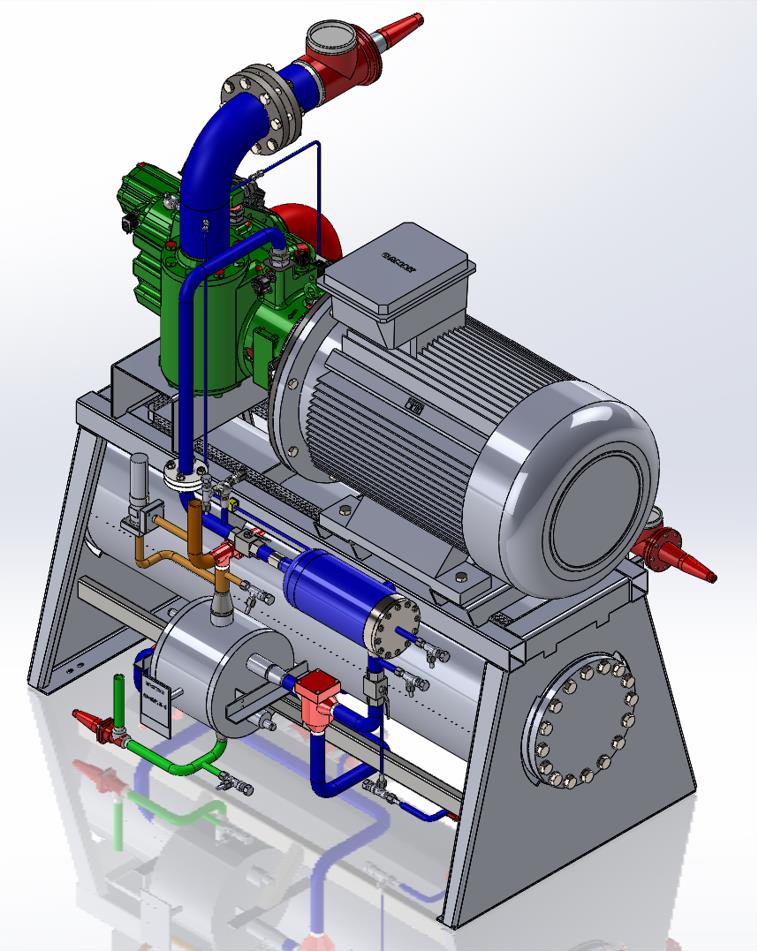NH3 /CO2 Cascade refrigeration system provides the ultimate solution for sustainable refrigeration system design. This system provides an HFC-free supermarket refrigeration solution while providing significant life-cycle cost savings for retailers.

NH3 /CO2 refrigeration system is a completely HFC-free refrigeration system designed to provide superior performance for food retail applications.

Introduction
This chapter provides an introduction to various vapor compression refrigeration systems and their applications.
Compressor Controls
The compressor is the "heart" of the refrigeration system and it has two basic functions: 1. Maintain the pressure in the evaporator so that the liquid refrigerant can evaporate at the required temperature; 2. Compress the refrigerant so that it can be condensed at a higher temperature.
Condensers
In areas where there are large variations in ambient air temperatures and/or load conditions, it is necessary to control the condensing pressure to maintain a high degree of system efficiency. Read about the different solutions in this chapter.
Condensers disperse the heat from the refrigeration system to the ambient air or water. Controlling the condenser is essential for the efficient operation of the refrigeration system.
Liquid level regulation
Liquid level regulation is an important element in the design of industrial refrigeration systems. It controls the liquid injection to maintain a constant liquid level. Read about the main principles; High pressure liquid level regulation system (HP LLRS) & Low pressure liquid level regulation system (LP LLRS)
Evaporator Controls
The evaporator is the part of the refrigeration system where the effective heat is transferred from the media you want to cool down (e.g. air, brine, or the product directly) to the refrigerant. Therefore, the primary function of evaporator control system is to achieve the desired media temperature.
Furthermore, the control system should also keep the evaporator in efficient and trouble-free operation at all times.
Oil systems
Generally, industrial refrigeration compressors are lubricated with oil, which is forced by the oil pump or by the pressure difference between the high and the low-pressure sides to the moving parts of the compressors (bearings, rotors, cylinder walls etc.). In this chapter you can read about control of oil temperature and oil pressure which are the two main oil parameters which needs to be controlled to guarantee reliable and efficient operation of the compressor.
Safety systems
All industrial refrigeration systems are designed with different safety systems to protect them against unsafe conditions, like excessive pressure. Any foreseeable excessive internal pressure should be prevented or relieved with minimum risk for people, property and the environment. Requirements on the safety systems are heavily controlled by authorities, and it is therefore always necessary to verify the requirements in the local legislation in various countries. Generally the illustrations in this chapter reflect the EN 13136 standard, but some should be considered to be ‘best practice’.
Refrigerant pump controls
Typically, industrial refrigeration systems have pump circulation of liquid refrigerant. There are some advantages of pump circulation compared with DX type systems. The pumps provide efficient distribution of liquid refrigerant to evaporators and return of vapor-liquid mixture back to the pump separator. By supplying more refrigerant than the evaporators can evaporate, called overfeed, it is possible to avoid superheating the refrigerant in the evaporator, thereby increase efficiency of the evaporators, without risk of liquid hammer in the compressor. In this chapter you get “best practice” within designing pump systems including capacity control and safety issues.
Air and water removal
This chapter covers industrial refrigeration applications for removal of water and air in the system as well as heat recovery systems. These applications aim at optimizing operation of the refrigeration systems, reducing the energy consumption and harvesting excess heat for other purposes, e.g. space heating or hot water production.
Using CO2 in refrigeration systems
This chapter covers the use of CO2 in industrial refrigeration applications. The use of carbon dioxide (CO2) in refrigeration systems is not new. Carbon dioxide was first proposed as a refrigerant by Alexander Twining (ref. [1]), who mentioned it in his British patent in 1850. Thaddeus S.C. Lowe experimented with CO2 for military balloons, but he also designed an ice machine with CO2 in 1867. Lowe also developed a machine onboard a ship for transportation of frozen meat.
Heat exchangers
Heat exchangers perform the primary duties of the refrigeration/heat pump systems - heating and cooling - as well as several internal functions. For efficient operation of heat exchangers, it is necessary that the system is both designed, constructed and controlled appropriately. The chapter will cover the usage of heat exchanger in a selection of refrigeration applications.
 Contact via WhatsApp
Contact via WhatsApp
